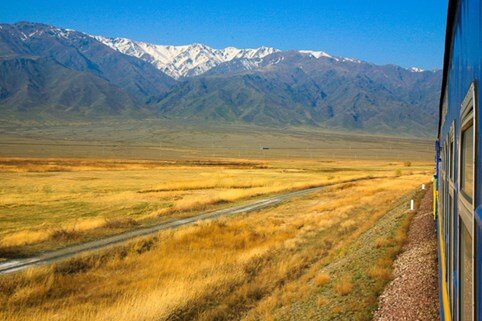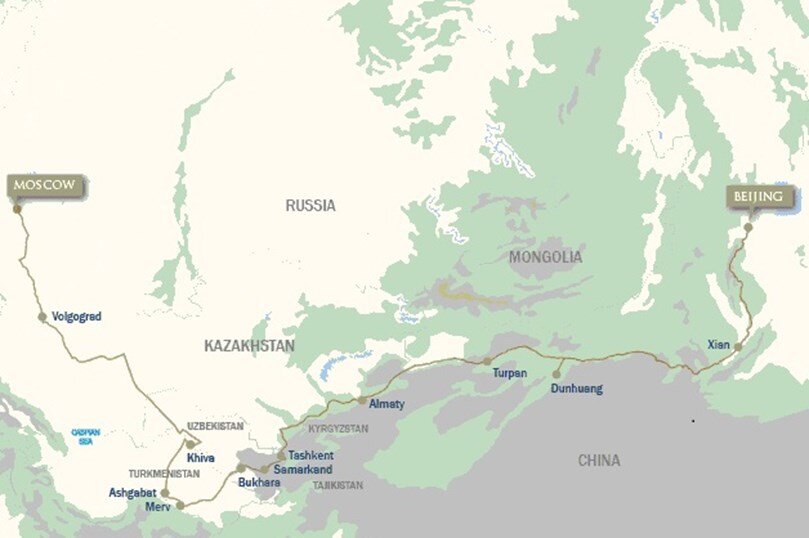rail-journeys
Golden Eagle: Silk Road Beijing-Moscow
22-day luxury Transmongolia Express5 countries: China, Uzbekistan, Turkmenistan, Kazakhstan, Russia
Journey to unique and remote places
Once in a lifetime experience


train
Most luxurious train in Russia
Private shower and toilet
Two beautifully equipped dining cars
For centuries, the Silk Road was the most important connection between east and west. Marco Polo, an Italian merchant, was the first foreigner to travel the route. Now follow in the footsteps of this world traveller and travel through sparsely populated areas, along high mountain ranges and through the impressive Gobi desert. While traveling you can still taste the atmosphere of the old trade life.
From the Forbidden City to the Red Square, right through the steppes of Central Asia; over 11,000 kilometers through 5 countries and many time zones. The train rides, time is standing still. From Beijing to the border with Kazakhstan, travel by Shangri-La Express. There you change to the comfortable Golden Eagle Trans-Siberian Express, which takes you to Moscow.
On this impressive journey you´ll experience the landscape and different cultures without renouncing comfort and safety.
Day 1-4: Arrival and Beijing (China)
Day 1 and 2: Arrive in Beijing. After arrival, you´ll be met for the transfer to the 5-star Regent Hotel (or similar) in the center where you´ll stay the next three nights. The rest of the day you´ll have plenty of time to acclimatize. In the evening you can meet your fellow travelers during a reception and welcome dinner.
Day 3: Today you´ll visit the huge Tiananmen Square (Square of Heavenly Peace), the impressive Forbidden City and the Celestial Temple. You´ll get demonstrations of traditional song and dance and calligraphy. You´ll also explore the narrow streets of a Hutong neighborhood by rickshaw (bicycle cab).
Alternatively, you can make an excursion to the old town of Cuandixia, located in the mountains 90 km west of Beijing. This place is known for its architecture and beautiful surroundings. It´s home to more than 500 well-preserved so-called courtyard houses from the Ming and Qing dynasties.
Day 4: On the program is the famous Chinese wall, the Great Wall, north of Beijing. The Chinese wall is the longest man-made structure in the world and is on the UNESCO World Heritage List.
Day 5 and 6: Xian (China)
Day 5: This morning the train will take you to Xian on the new high speed line with 300 km per hour in about 5 hours. Xian was once the capital of China and now mainly known for the Terracotta army. The army consists of about 6,000 terracotta figures that were given as a grave gift to the first emperor of China, Qin Shi Huangdi. This emperor believed that his grave was the palace for eternity and that life under the ground was a continuation of his life on earth.
In addition to the mausoleum, the burial mound consisted of temples and administrative buildings and had a size of more than 2.5 km². Around his tomb there are burial chambers with donations to ensure that his soul was nourished and protected in the afterlife. At the end of the construction of the tomb, the people who had helped were buried alive in the underground palace so that their existence would remain a secret. The army was only discovered by peasants 40 years ago.
The tomb has never been opened and only a few of the hundred or so burial chambers have been opened. It´s believed that with the current techniques it´s not yet justified to excavate the tomb of the emperor without damaging it. You have a few hours to walk around here and marvel at this amazing archaeological find. In the evening you can enjoy the Tang Dynasty Dinner, Music and Dance Show. Overnight stay is in the Sofitel Xian Hotel.
Day 6: After breakfast you can participate in a city tour along the highlights of Xian such as the Great Mosque, the Drum and Bell Tower and explore the 14 km long city walls by bike.
In the afternoon you´ll board the Shangri-La Express, which will take you through China. Passengers staying in an Imperial Suite or Gold Class on the Golden Eagle will have a Diamond Class cabin on the Shangri-La Express, with its own shower and toilet. Passengers with a Silver Class on the Golden Eagle will stay on the Shangri-La Express in Heritage Class, with shared toilet and shower. In the evening, a welcome dinner will be served in the dining car where you´ll get acquainted with authentic Chinese cuisine.
Day 7, 8 and 9: Dunhuang and Turpan (China)
Day 7: After a relaxing morning aboard the train, you arrive in Dunhuang, an oasis city in the Gobi Desert. By camel you´ll go through the desert to the Lake of the Washing Moon. Dinner will take place in this magical setting of the desert, accompanied by a performance of local musicians. Overnight stay at the Silk Road Dunhuang hotel.
Day 8: You wake up early to witness the impressive sunrise over the sand dunes. After this you´ll visit the fascinating Magao Caves, also known as the Thousand Buddha Cave Complex. Between the 4th and the 12th century Buddhist monks carved about 1,000 caves into the sandstone rocks and decorated them with Buddhist art, such as Buddha statues, sculptures and murals. Half of these have been preserved and some of them are open to the public.
After this you´ll return to the train where dinner and accommodation will take place.
Day 9: Oasis city Turpin is the lowest located place in the world and is also called the furnace of China. In the summer temperatures can reach up to 40 degrees. The soil here is particularly suitable for grapes, partly due to a medieval underground irrigation system. A visit to the museum of Turpan is on the program, including an exhibition of mummies of 3,200 years old.
Final destination today is the deserted sandstone town of Jiaohe which was founded in 108 BC and was an important place on the Silk Road until it was abandoned in the 13th century after an attack and looting of the troops of Dzengis Khan.
Overnight stay in the train.
Day 10 and 11: On board of the Golden Eagle and Almaty
Day 10: On the border China-Kazachstan near Alashankou, after breakfast, you´ll leave the Shangri-La Express and change to the Golden Eagle. The border formalities take about 5 hours, after that you can settle down in your comfortable compartment in the Golden Eagle.
Day 11: Almaty is the largest city of Kazakhstan and used to be called Alma-Ata. The green city is surrounded by the Tien Shan Mountains. Alma means 'apple', the apple orchards outside the city are numerous. You´ll visit the Panfilov Park, with the wooden Zenkhov Cathedral. With a cable car ride, you´ll get a spectacular view over the city and the surrounding mountains.
Day 12 and 13: Tashkent and Samarkand (Uzbekistan)
Day 12: Tashkent is the capital of Uzbekistan. The city was rebuilt after an earthquake in 1966 and is partly because of this a modern city, with a subway, universities and offices of major European and American companies. The city is known for its tree-lined streets, countless fountains and many benches.
The excursion will take you to the Old Town, with traditional houses and religious buildings along narrow streets. Very special is the visit to a small library where you can see the oldest Koran in the world, one of the holiest relics of Islam. Afterwards, you can visit the Railway Museum and the Museum of Applied Art. Overnight stay in the train.
Day 13: Samarkand was founded as an oasis city in the 6th century BC. This city on the world heritage list is also called the "Paris of the Muslim World". The architecture clearly shows that it´s once one of the most important cities in Asia. An excursion will take you past all the major attractions such as the Registan, the beautiful square in the center of Samarkand. At the square there are three large madrassas, Islamic schools.
You´ll also visit the Bibi Khanum Mosque and Ulag Beg, one of the earliest Islamic astronomical observatories, built in 1428. Overnight stay in the train.
Day 14: Buchara (Uzbekistan)
Arrival in beautiful Buchara. This city is world heritage and exists more than 2500 years. It´s known for its embroidery. Especially gold embroidery has a long tradition here. This important city of Uzbekistan has many attractions. The highlight is a visit to the "Ark of Buchara", the fortress in which the Emirs resided. You can also visit the Moon and Star Palace of the Emir outside the city. If the weather permits you can enjoy a barbecue at the train station.
Day 15 and 16: Merv and Ashgabat (Turkmenistan)
Day 15: Merv is a historic city in an oasis in Turkmenistan. In the 12th century this was the largest city in the world, and it was an important stop on the Silk Road. When the dam was destroyed on which the population depended for their water supply, the city lost its significance. According to Unesco, Merv is the oldest and best preserved oasis city. The historic city center consists of a number of adjacent walled cities.
Overnight stay on board of the train.
Day 16: Today you´ll visit Ashgabat, the capital of Turkmenistan and the 'Las Vegas of the Karakum'. The city lies between the desert and the Kopet-Dag Mountains and is relatively modern because of the reconstruction after the heavy earthquake of 1948. You´ll see extravagant fountains, golden domes, marble sidewalks. You´ll also visit the National Museum and the Kipchak mosque.
On the way to Uzbekistan, the train makes a short stop in Ichoguz to visit the famous gas crater of Derweze, a spectacular sight, especially when it´s dark. The gas crater is located in the middle of the Karakum desert, has a diameter of 70 meters and has been burning for over 40 years. The locals call the crater "Gateway to Hell". Overnight stay in the train.
Day 17: Khiva (Uzbekistan)
Today you´ll arrive in Khiva in Uzbekistan. This city was founded 2500 years ago and was once an important center at the crossroads of trade routes between Mongolia, Russia, China and Persia. You´ll visit the walled city center with the unfinished Kalta Minar minaret, the Djuma mosque (Friday mosque), madrassas (Islamic schools), the bazaar, fortresses and palaces. Overnight stay in the train.
Day 18 and 19: Karakum desert and Volgograd (Russia)
Day 18: This day you´ll spend aboard the Golden Eagle as it crosses the Karakum desert of Kazakhstan. The name of the desert means 'red sand'. You can take Russian lessons or get to know your fellow passengers even better. Overnight stay aboard the train.
Day 19: Volgograd is the former Stalingrad and lies on the banks of the Volga. Here one of the most important battles of the Second World War took place. The Russians overpowered the German armies here and this was a turning point in the war. You´ll visit the war memorial Mother of the Netherlands on the Mamayev hill and the informative museum. Last night aboard the train.
Day 20, 21 and 22: Moscow and return to Amsterdam.
Day 20: After covering more than 11,250 km from Beijing, the train arrives in Moscow today and says goodbye to the Golden Eagle and its crew. You´ll spend two nights at the comfortable Four Seasons Hotel Moscow (or similar) in the city center, within walking distance of Red Square and the Bolshoi Theatre.
Day 21: You can enjoy an extensive city tour including the Red Square with the Basilius Cathedral and the Kremlin with the Treasury. You can also choose from alternative excursions, for example a visit to the Tretyakov Gallery or the National Museum of Fine Arts.
Day 22: Transfer to the airport follows in the course of the morning. Fly home from Moscow.
price-dates
Golden Eagle: Silk Road Beijing-Moscow



